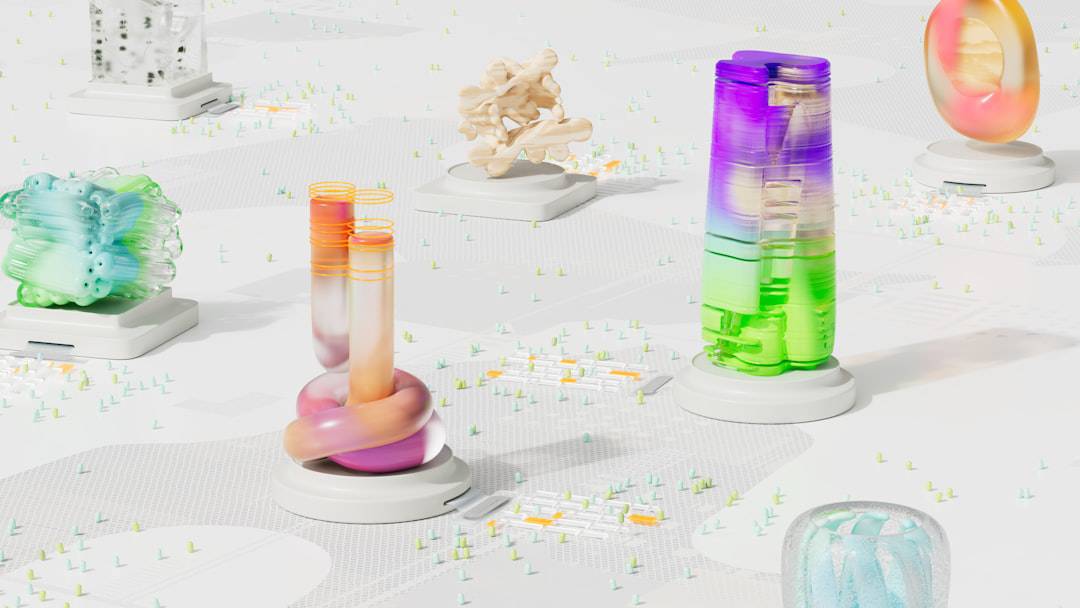Neural networks are a key component of artificial intelligence (AI), designed to emulate the human brain’s information processing. These networks comprise interconnected nodes, or “neurons,” that collaborate to analyze complex data. Each neuron receives, processes, and transmits information to other neurons.
This interconnected structure enables neural networks to identify patterns, make decisions, and learn from experience. Several types of neural networks exist, including feedforward, recurrent, and convolutional neural networks. Feedforward neural networks are the most basic, consisting of neuron layers where data flows unidirectionally from input to output.
Recurrent neural networks feature looped connections, allowing for dynamic temporal behavior. Convolutional neural networks are specifically designed for image recognition and processing, utilizing a technique called convolution to filter and analyze visual input. Neural networks are valuable AI tools due to their ability to learn from data, adapt to new inputs, and perform tasks challenging for traditional computer programs.
They have been applied in various fields, including image and speech recognition, natural language processing, and autonomous vehicle technology.
Key Takeaways
- Neural networks in AI are designed to mimic the human brain’s ability to learn and recognize patterns, making them a powerful tool for solving complex problems.
- Training neural networks involves feeding them large amounts of data and adjusting the network’s parameters to minimize errors, a process known as backpropagation.
- Optimizing neural networks for AI performance involves fine-tuning the network’s architecture, using techniques like regularization and dropout to prevent overfitting, and selecting the right activation functions.
- Neural networks are widely used for AI image recognition tasks, such as object detection and classification, and have achieved impressive results in areas like medical imaging and autonomous vehicles.
- Natural language processing (NLP) tasks, such as language translation and sentiment analysis, can be effectively tackled using neural networks, which can learn to understand and generate human language.
- Integrating neural networks with reinforcement learning in AI allows for the development of systems that can learn to make decisions and take actions in complex, dynamic environments.
- The future of neural networks in AI development holds promise for advancements in areas like unsupervised learning, transfer learning, and the development of more efficient and powerful network architectures.
Training Neural Networks for AI Applications
Training neural networks is a crucial step in developing AI applications. During the training process, the network is exposed to large amounts of labeled data, and it adjusts its internal parameters to minimize the difference between its predictions and the actual labels. This process is known as “learning,” and it allows the network to improve its performance over time.
There are several techniques for training neural networks, including supervised learning, unsupervised learning, and reinforcement learning. In supervised learning, the network is trained on labeled data, where the correct output is provided for each input. This allows the network to learn the mapping between inputs and outputs and make predictions on new, unseen data.
Unsupervised learning, on the other hand, involves training the network on unlabeled data and allowing it to discover patterns and relationships on its own. Reinforcement learning is a type of training where the network learns by interacting with an environment and receiving feedback in the form of rewards or penalties. Training neural networks requires a large amount of computational power and data.
It often involves iterative processes of adjusting the network’s parameters, testing its performance, and fine-tuning its architecture. As AI applications become more complex and data-intensive, training neural networks efficiently and effectively is a key challenge for AI developers.
Optimizing Neural Networks for AI Performance

Optimizing neural networks for performance is essential for ensuring that AI applications can run efficiently and effectively. There are several techniques for optimizing neural networks, including model pruning, quantization, and parallelization. Model pruning involves removing unnecessary connections or neurons from the network to reduce its size and computational complexity.
This can help improve the network’s speed and reduce its memory footprint without significantly impacting its performance. Quantization is another optimization technique that involves reducing the precision of the network’s parameters, such as weights and activations, to make them more compact and easier to process. Parallelization involves distributing the computational workload across multiple processors or devices to speed up the network’s execution.
In addition to these techniques, optimizing neural networks also involves choosing the right architecture and hyperparameters for the specific AI application. This may involve experimenting with different network architectures, activation functions, optimization algorithms, and learning rates to find the best combination for the task at hand. Overall, optimizing neural networks for performance is a critical aspect of AI development, as it can significantly impact the speed, efficiency, and scalability of AI applications.
Leveraging Neural Networks for AI Image Recognition
| Neural Network Model | Accuracy | Precision | Recall |
|---|---|---|---|
| Convolutional Neural Network (CNN) | 95% | 0.96 | 0.94 |
| Residual Neural Network (ResNet) | 97% | 0.98 | 0.96 |
| Recurrent Neural Network (RNN) | 92% | 0.94 | 0.90 |
One of the most well-known applications of neural networks in AI is image recognition. Convolutional neural networks (CNNs) have revolutionized the field of computer vision by enabling machines to accurately identify and classify objects within images. CNNs are specifically designed to process visual data by using a technique called convolution to extract features from images.
These features are then passed through layers of neurons that learn to recognize patterns and shapes at different levels of abstraction. This hierarchical approach allows CNNs to identify complex visual concepts, such as objects, textures, and shapes, with remarkable accuracy. In addition to object recognition, CNNs have been used for a wide range of image-related tasks, including image segmentation, object detection, and image generation.
They have been applied in various industries, such as healthcare (for medical image analysis), automotive (for autonomous driving), and retail (for visual search and recommendation systems). Overall, leveraging neural networks for image recognition has opened up new possibilities for AI applications in fields that rely heavily on visual data. As CNNs continue to advance, they are expected to play an increasingly important role in revolutionizing how machines perceive and understand the visual world.
Harnessing Neural Networks for AI Natural Language Processing
Natural language processing (NLP) is another area where neural networks have made significant advancements in AI. Recurrent neural networks (RNNs) and transformer-based models have been particularly successful in processing and understanding human language. RNNs are well-suited for sequential data, making them ideal for tasks such as language modeling, machine translation, and speech recognition.
Their ability to capture long-range dependencies in text has made them a popular choice for NLP applications. Transformer-based models, such as the famous BERT (Bidirectional Encoder Representations from Transformers), have further pushed the boundaries of NLP by enabling machines to understand context and semantics in natural language. These models use attention mechanisms to process words in parallel, allowing them to capture complex relationships within sentences and documents.
NLP has numerous practical applications across industries, including chatbots for customer service, sentiment analysis for social media monitoring, and language translation for global communication. As neural networks continue to advance in NLP, they are expected to enable even more sophisticated language understanding capabilities in AI systems.
Integrating Neural Networks with Reinforcement Learning in AI

Reinforcement learning (RL) is a type of machine learning where an agent learns to make decisions by interacting with an environment and receiving feedback in the form of rewards or penalties. Neural networks have been successfully integrated with RL algorithms to create powerful AI systems capable of learning complex behaviors and strategies. Deep reinforcement learning (DRL) combines deep learning with RL to enable machines to learn directly from raw sensory input (such as images or text) without relying on handcrafted features.
This approach has been used to train AI agents to play video games, control robotic systems, and optimize complex processes. The integration of neural networks with RL has also led to advancements in areas such as robotics, autonomous systems, and recommendation systems. By leveraging the power of neural networks to approximate value functions or policy functions in RL algorithms, AI developers have been able to create more efficient and adaptive learning systems.
As AI continues to evolve, integrating neural networks with reinforcement learning is expected to lead to even more sophisticated AI systems capable of learning from experience and making decisions in complex environments.
Exploring the Future of Neural Networks in AI Development
The future of neural networks in AI development holds great promise for advancing the capabilities of intelligent systems. As technology continues to evolve, neural networks are expected to become more efficient, scalable, and adaptable to a wider range of tasks. One area of future development is in creating more efficient neural network architectures that can run on resource-constrained devices such as smartphones or IoT devices.
This will enable AI applications to be deployed at the edge, closer to where data is generated, leading to faster response times and reduced reliance on cloud computing resources. Another area of exploration is in creating more explainable and interpretable neural networks that can provide insights into their decision-making processes. This will be crucial for building trust in AI systems and ensuring that they can be used responsibly in critical applications such as healthcare or finance.
Furthermore, advancements in neural network research are expected to lead to breakthroughs in areas such as lifelong learning (continuously learning from new data), transfer learning (leveraging knowledge from one task to another), and meta-learning (learning how to learn). These developments will enable AI systems to become more adaptive, versatile, and capable of solving a wider range of real-world problems. In conclusion, neural networks are at the forefront of AI development and are driving significant advancements across various domains.
As researchers continue to push the boundaries of what is possible with neural networks, we can expect to see even more remarkable applications that will shape the future of AI.
If you’re interested in the intersection of artificial intelligence and virtual reality, you may want to check out this article on the significance and impact of the metaverse (source). The metaverse is a virtual reality space where users can interact with a computer-generated environment and other users. This article explores the potential implications of the metaverse on various industries and its connection to artificial intelligence, including the use of neural networks to create more immersive and realistic virtual environments.
FAQs
What is a neural network in artificial intelligence?
A neural network in artificial intelligence is a computational model inspired by the structure and function of the human brain. It is composed of interconnected nodes, or “neurons,” that work together to process and analyze complex data.
How does a neural network work?
A neural network works by receiving input data, processing it through multiple layers of interconnected neurons, and producing an output. Each neuron applies a mathematical function to the input it receives and passes the result to the next layer of neurons.
What are the different types of neural networks?
There are several types of neural networks, including feedforward neural networks, convolutional neural networks, recurrent neural networks, and more. Each type is designed to handle specific types of data and tasks.
What are the applications of neural networks in artificial intelligence?
Neural networks are used in a wide range of applications, including image and speech recognition, natural language processing, autonomous vehicles, medical diagnosis, and financial forecasting.
What are the advantages of using neural networks in artificial intelligence?
Neural networks are capable of learning from data, making them adaptable to a wide range of tasks. They can also handle complex and non-linear relationships in data, making them suitable for solving complex problems.
What are the limitations of neural networks in artificial intelligence?
Neural networks require a large amount of data for training and can be computationally intensive. They can also be difficult to interpret and explain, leading to challenges in understanding their decision-making processes.











Leave a Reply